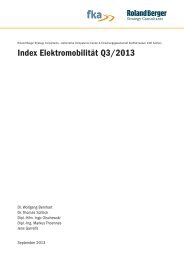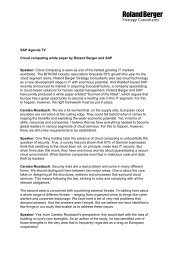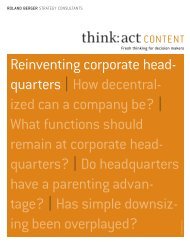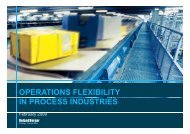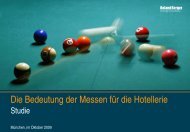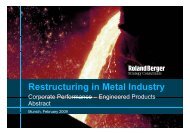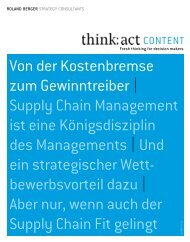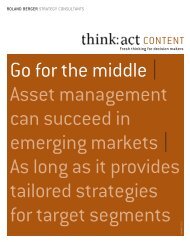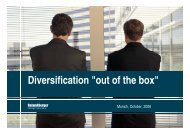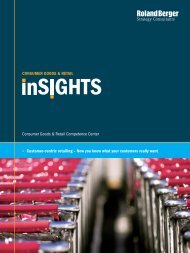The global aerostructures tooling equipment market - Roland Berger
The global aerostructures tooling equipment market - Roland Berger
The global aerostructures tooling equipment market - Roland Berger
- No tags were found...
You also want an ePaper? Increase the reach of your titles
YUMPU automatically turns print PDFs into web optimized ePapers that Google loves.
Source: <strong>Roland</strong> <strong>Berger</strong>Areostructures_Tooling_Equipment_FINAL_short.pptx6ARESEARCH APPROACH AND MARKET DEFINITION<strong>The</strong> <strong>global</strong> <strong>aerostructures</strong> <strong>tooling</strong> <strong>equipment</strong> <strong>market</strong> study coversnearly all leading industry players and expert sourcesGlobal <strong>aerostructures</strong> <strong>tooling</strong> <strong>equipment</strong> <strong>market</strong> studyEQUIPMENT SUPPLIERSDESK RESEARCHGlobal AerostructuresTooling EquipmentMarket 2010-2020INDUSTRY INTERVIEWSCUSTOMER INTERVIEWS
ARESEARCH APPROACH AND MARKET DEFINITIONWe followed a unique, detailed approach – Relevant <strong>market</strong> derivedfrom underlying customer <strong>market</strong>s worldwideStudy approach and resultsSTUDY APPROACHResults> Market development (productoffering, segments and regions)> Current and future customerrequirements along value chainGlobal civil and militaryaircraft <strong>market</strong>Aerostructures<strong>market</strong>Tooling<strong>equipment</strong> <strong>market</strong>> Relationship between <strong>market</strong>drivers for OEMs and the<strong>aerostructures</strong> and <strong>equipment</strong><strong>market</strong>sStarting point is a forecastfor the OEM <strong>market</strong> forcivil and military aircraftand helicopters by modelBased on a detaileddemand forecast, wederive the <strong>global</strong><strong>aerostructures</strong><strong>market</strong> of OEMs andTier 1-3Using our insights intocustomer <strong>market</strong>s, wethen forecast the<strong>tooling</strong> <strong>equipment</strong><strong>market</strong> in detail> Technology trends in aerospaceindustry and influence on<strong>equipment</strong> manufacturers> Current and future successfactors for <strong>tooling</strong> <strong>equipment</strong>manufacturersSource: <strong>Roland</strong> <strong>Berger</strong>Areostructures_Tooling_Equipment_FINAL_short.pptx7
ARESEARCH APPROACH AND MARKET DEFINITIONFrom a customer perspective, the <strong>aerostructures</strong> <strong>tooling</strong> <strong>equipment</strong><strong>market</strong> can be clustered into three main segmentsMarket definition and scope of the studySegmentScope of study: <strong>aerostructures</strong> <strong>tooling</strong> <strong>equipment</strong>Not in scopeIIIIIDRILLING &RIVETINGPOSITION-INGJIGS,HANDLINGANDTRANSPORTSYSTEMS1) CFRP: carbon fiber reinforced plastics> Automated and semi-automated systemsand <strong>equipment</strong> for drilling, riveting andwelding components/modules> Major suppliers: Brötje Automation,ElectroImpact, Gemcor, Loxin 2002> Systems for high-precision movement andpositioning of components and moduleswithin the assembly process> Major suppliers: AIT, Brötje Automation,Dürr, ECA, MCE> Manual and automated systems for fixing,mounting, storage and transportation ofcomponents and modules> Major suppliers: virtually all OEMs,<strong>aerostructures</strong> and <strong>equipment</strong> suppliersCFRP 1)manufacturing> Machines formanufacturingCFRP parts,mainly automatedtape laying(ATL) andautomated fiberplacement (AFP)machinesSource: Expert interviews, <strong>Roland</strong> <strong>Berger</strong>Areostructures_Tooling_Equipment_FINAL_short.pptx8
Areostructures_Tooling_Equipment_FINAL_short.pptx9B. Market for <strong>aerostructures</strong> <strong>tooling</strong> <strong>equipment</strong>
BMARKET FOR AEROSTRUCTURES TOOLING EQUIPMENTFour drivers characterize automated <strong>tooling</strong> <strong>equipment</strong> <strong>market</strong> – Newprogram launch, rate increases, cost pressure & new technologyMajor <strong>market</strong> drivers – overviewStart of new programs> Launch of new programs requires developmentand installation of customized <strong>equipment</strong>Rate increases in existing programs> Significant increases of cadence for existingmodels require higher automation and processindustrialization and even add-on capacityCost/efficiency pressure> Increase in productivity to reduce unit costs> Increase in process stability/reproducibility andreduction of supply chain risksNew technology & materials> New, more efficient technology and materialsdrive adjustments/replacements of <strong>equipment</strong>IPURCHASING NEWEQUIPMENT> Development and procurement of new, modelspecificsystems and <strong>equipment</strong> formanufacturing and assembly> Investment often within a period of 2-4 yearsIIINDUSTRIALIZATION> Upgrades/updates of <strong>equipment</strong> & systems> Partial or full automation of manual processes> Increase of process stability throughautomation, measuring and control technologyIIIOPTIMIZATION OF EQUIPMENT> Process optimization based on existing <strong>equipment</strong> withminimal investment to increase outputVolatile demandmainly driven byoverall economicdevelopmentSource: Expert interviews, <strong>Roland</strong> <strong>Berger</strong>Areostructures_Tooling_Equipment_FINAL_short.pptx10
BMARKET FOR AEROSTRUCTURES TOOLING EQUIPMENTIn 2010, the <strong>tooling</strong> <strong>equipment</strong> <strong>market</strong> was worth USD 1.1 bn –Largest segment is positioning systems for final assemblyGlobal <strong>aerostructures</strong> automated <strong>tooling</strong> <strong>equipment</strong> <strong>market</strong> 1) , 2010 [USD m]TOTAL VOLUME: USD 1,110Jigs,transport,logistics(total: 432)Positioning(total: 423)Riveting, drilling,robotics(total: 115)270127(47%)98(36%)45(17%)Sub-moduleassembly1) Excluding automated carbon fiber <strong>equipment</strong> (AFP, ATL)300125(42%)125(42%)50(17%)Moduleassembly400180(45%)200(50%)20(5%)Final assembly140ServiceCOMMENTS> Jigs, transport, logistics andpositioning systems are the largestsegments, worth approx. USD 430 min total in 2010> Riveting and drilling <strong>equipment</strong> havearound a 10% <strong>market</strong> share – mainapplication in sub-module (e.g.fuselage shells/hull) and moduleassembly (e.g. fuselage sections)> Within final assembly there is limitedautomated riveting and drilling<strong>equipment</strong> demand – large share ofmanual labor supported by jigs andpositioning systems> Demand for jigs and handlingsystems grows with increasingcomponent sizeSource: Expert interviews, <strong>Roland</strong> <strong>Berger</strong>Areostructures_Tooling_Equipment_FINAL_short.pptx11
BMARKET FOR AEROSTRUCTURES TOOLING EQUIPMENTDemand will remain at record levels in the short term – Significantdownturn and shift to service expected from 2013 onwardsAerostructures <strong>tooling</strong> <strong>equipment</strong> <strong>market</strong>, 2006-2020e (illustrative) [USD m]904781 14%15%+83%1.4261.290 10%1.2021.11911%1.11012%12% 13%89016%89%88% 87%85%86% 84%06 07 08 09 10 11eService EquipmentNote: USD:EUR exchange rate: 1.3590%88%12e 13e94417%83%14e78923%77%15e-73%63631%69%16e42552%48%17eAs of today nonew programsafter 2016announced36463%37%18e38063%37%19e38562%38%20eCOMMENTS> A350 (and last phase of B787 <strong>tooling</strong>)drive peaking <strong>market</strong> in 2011 and 2012> Start-up of new programs in China andRussia dampens the declining demandin medium term from 2013 onward> Slump after 2016 due to lack of newprograms at that stage between EIS ofA320 NEO/B737 MAX and end of thedecade on LCA> Substantial shift towards optimizationand retrofit of existing <strong>equipment</strong>causes significantly reduced volume> Rate increases covered by optimizationof existing systems with only lowinvestments – significant rate increasesrealized by duplication of existingsystems including minor adjustments/improvementsSource: Expert interviews, <strong>Roland</strong> <strong>Berger</strong>Areostructures_Tooling_Equipment_FINAL_short.pptx12
BMARKET FOR AEROSTRUCTURES TOOLING EQUIPMENT<strong>The</strong> <strong>market</strong> is indirectly driven by growth in customer <strong>market</strong>s –Primary strategic and operational requirements identifiedRelationship of <strong>market</strong> drivers in OEM, <strong>aerostructures</strong> and <strong>tooling</strong> <strong>equipment</strong> <strong>market</strong>OEM (aircraftmanufacturing)> Growth of world economy> Growth of <strong>global</strong> trade> Liberalization of air space> Development of oil/kerosene price> Development of wagesStrategic requirements> Consolidation and specializationof players> Internationalization and expansionof footprint for targeting new<strong>market</strong>s> Taking on development andfinancing risksOperational requirements> Handling of complete system/module responsibility> Industrialization of manufacturing and assemblyprocess> Integration of new materialsAerostructuresmanufacturing> Global fleet growth> Governmental industrial policy> Cost and efficiency pressures> Risk reduction by OEMsStrategic requirements> Global turnkey capabilities for large projects> Acting as a problem-solving partner for thecomplete manufacturing and assembly process> Local engineering and after-sales expertiseOperational requirements> Suitability for interdisciplinary<strong>global</strong> development partnerships> Greatest process stability andreproducibility> Flexible system design and broadareas of applicationEquipmentmanufacturing> Start/ramp-up of new programs> Increase of production rates> Cost/efficiency pressure> New technologySource: Expert interviews, <strong>Roland</strong> <strong>Berger</strong>Areostructures_Tooling_Equipment_FINAL_short.pptx13
BMARKET FOR AEROSTRUCTURES TOOLING EQUIPMENTSix major trends influencing the <strong>tooling</strong> <strong>equipment</strong> <strong>market</strong> havebeen identified – Varying impact on supplier depending on segmentTREND1 Industrialization2 Flexibility 3 Cost optimization4 Materialmix5 Risksharing6 ServiceIMPLI-CATIONSIMPACT ON SUPPLIER> Transition fromfactory to serialproduction> Standardizedprocesses,automation andprocess flow> Transfer of bestpractices fromother industries> One tool formultiple models/modules> More flexibleand accessiblework station capableof multipleoperations> Automated,software-basedprocess control> Standardizationand modularizationwithout qualitycompromises> Product costpressurethroughemerging<strong>market</strong>s andOEMs> Two clustersidentified (singleaisle vs. twinaisle) – highCFRP share fortwin aisle andmedium sharein single aisle> Recent CFRPboom expectedto slow down> OEMs focus oncompetencies"systemintegration" and"programmanagement"> Supplier riskmanagementand financialstrength criticalto fulfillrequirements> Local solutioncompetence> Necessaryengineering andprocess knowhow> Optimization ofexisting <strong>equipment</strong>Drill & RivetPositioningJigs & transportsystemsLowHighSource: Expert interviews, <strong>Roland</strong> <strong>Berger</strong>Areostructures_Tooling_Equipment_FINAL_short.pptx14
BIMARKET FOR AEROSTRUCTURES TOOLING EQUIPMENT – INDUSTRIALIZATIONCost efficiency and industrialization are driving the <strong>market</strong> –Automation is only viable in certain programs and regionsUse of process automation and production cadences by segment and region, 2011-2020[no. of A/C per month]TypeREGIONALEmbraer ERJ-190, ART 42/72, DHC-8-400BUSINESSCessna Citation Mustang, Embraer Phenom 100LCA – SINGLE-AISLEA318-321, B787-6 to 9LCA – TWIN-AISLEA330, B777, A380, B767, B787, B747-8HELICOPTEREurocopter AS350, Sikorsky UH-60Europe1-230-400-70-142011 2011, relevant size for automation2020Americas1-630-400-60-9Asia2-4Russia1-4 0-60.110.50.1COMMENTS> Production rates for all civilaircraft segments will increase tomeet <strong>global</strong> demand for newaircrafts, plus the start and rampupof new programs> Increasing production ratedrives industrialization and automationin today's core <strong>market</strong>s> Start of new programs in Asiaand Russia is shifting <strong>market</strong>s> Evolving <strong>aerostructures</strong> players inAsia and Russia require simplersystems at lower costs but withsame accuracy> Players from emerging <strong>market</strong>sstrive for turnkey solutions dueto their lack of expertise in aircraftand <strong>aerostructures</strong> productionSource: Teal, expert interviews, <strong>Roland</strong> <strong>Berger</strong>Areostructures_Tooling_Equipment_FINAL_short.pptx15
BIIMARKET FOR AEROSTRUCTURES TOOLING EQUIPMENT – FLEXIBILITYFlexibility in machinery setup and production processes is enabledby software machine controlling and automated process monitoringDimensions of flexibilityMulti-model machinery> Similar aircraft models (e.g. A318 andA321 on one production line)> Regular updates of <strong>aerostructures</strong> designdue to product efficiency requirements> Supplier's need for lower dependency onspecific models/componentsFlexible production lines> Frequent re-design of processes andcomponents with effect on machinerysystems (configuration management)> Supplier's thrive for lower investmentsdue to more generic production lines andhigher integration to reduce riskGrowing importance of software> One system solution for multiplemodels/modules> Machinery to be adjusted ratherthan replaced, software controlsrequired quality and precisionLearning from other industries> Optimization of existingprocesses to increase efficiency> Higher integration andconnectivity of individual systems> Automated process monitoring asprocess enablerFlexibilitythroughoutthe <strong>aerostructures</strong>productionprocessSource: Expert interviews, <strong>Roland</strong> <strong>Berger</strong>Areostructures_Tooling_Equipment_FINAL_short.pptx16
BIIIMARKET FOR AEROSTRUCTURES TOOLING EQUIPMENT – COST OPTIMIZATIONEmerging <strong>market</strong>s and overcapacities in the near future require costoptimization through standardization and modularizationDrivers and impact of cost optimizationDEMAND FROM EMERGINGMARKETS> Demand shift towards emerging<strong>market</strong>s> New program launches inemerging <strong>market</strong>s such asRussia, China and Latin America> Rise of <strong>aerostructures</strong> productionin emerging <strong>market</strong>s withdifferent cost structure increasesprice pressure> New <strong>market</strong>s and customersrequire simpler systems andturnkey solutions at reducedcost"NO FRILLS"Cost optimization throughproduct standardization andmodularizationCOST AND EFFICIENCYPRESSURE> Global demand decline comparedto current peak is expected toresult in overcapacity> OEM cost reduction initiativesforce Tier-1s to reduce shipsetprices (e.g. SCOPE, Blue Sky)> Strong focus on short ROI fornew <strong>equipment</strong> investments> Price pressure in all <strong>market</strong>snecessitates production and costefficiency on the same level ofaccuracySource: Expert interviews, <strong>Roland</strong> <strong>Berger</strong>Areostructures_Tooling_Equipment_FINAL_short.pptx17
BIVMARKET FOR AEROSTRUCTURES TOOLING EQUIPMENT – MATERIAL MIXLarge aircraft currently being developed have a composite share ofover 50% – No further increase is expected at firstMaterial mix development as a share of total weight of aircraft structure [%]Boeing Airbus Bombar UAC Comac LCA 1)-dier2020e3 2 3B737 B747 B767 B777 B7871 4 3 1 111 1 5512 13 147115079 79 8070 1510201967 1969 1981 1994 2011OtherCompositeTitaniumA300/3107658741985SteelA350A330/A320 340 A38065 55525 58 8 7 715 16 2266 6619871992Aluminum61147202007 ~2014C- Series MS-21 C919 Ø 20205 5-10 530 2)4624~20153819533~201920-3015-205-1030-40~201925-307850-55Impact> Up to B787 and A350, significantincrease in composite share("CFRP hype")> Updates of current single-aisleaircrafts (A320neo and B737max)are planned without a significantincrease in the proportion ofCFRP compared to A320 & B737> Material mix (metal vs. carbonfuselage) of new ("post-neo")single-aisle generation aircraft notyet defined, but clear preferencefor metal"Composite percentage remainsfrozen at today's level – the newA30X will have a metal fuselage"– Head of Procurement at Airbus1) average material mix Large Commercial Aircrafts (LCA) in 20202) including steel and titaniumSource: Teal, expert interviews, Russia & CIS Military Newswire, <strong>Roland</strong> <strong>Berger</strong>Areostructures_Tooling_Equipment_FINAL_short.pptx18
BVMARKET FOR AEROSTRUCTURES TOOLING EQUIPMENT – RISK SHARINGOEM's demand for outsourcing larger workpackages drives ongoingconsolidation of <strong>aerostructures</strong> landscape towards "Super Tier 1s"Evolution of <strong>aerostructures</strong> industrySituation todayNear-term upcoming<strong>market</strong> consolidationImpactOEMTier 1Tier 2Supplier AAirbus (FAL)Supplier BSpecsDeliveriesSupplier CDeliveriesOEMs hand over design and supply chainmanagement to tier-1s and require risk-sharingpartnerships and large upfront investments –Some take over value chain managementSupplier AAirbus (FAL)Supplier BSupplier CPositioning as "sub-supplier" notsustainable – Players will either have toinvest heavily and actively driveconsolidation or exit> OEMs hand over responsibility &risk to Super Tier 1s by givingthem design & supply chainresponsibility for completeworkpackages / systems> Responsibility for largerworkpackages together withdelay of aircraft programs (e.g.B787 or A350) demands strongfinancial backbone to ensureliquidity – But <strong>aerostructures</strong> ischaracterized by a fragmentedindustry structure in Europe andpoor financial performance ofplayers> Players from emerging <strong>market</strong>swith a strong financial backbonedrive consolidation in EuropeSource: Expert interviews, <strong>Roland</strong> <strong>Berger</strong>Areostructures_Tooling_Equipment_FINAL_short.pptx19
BVIMARKET FOR AEROSTRUCTURES TOOLING EQUIPMENT – SERVICEDecreasing demand in key <strong>market</strong>s is cushioned by increasingservice demand – New service models are requiredEvolution of after-sales and service <strong>market</strong> for <strong>tooling</strong> <strong>equipment</strong>ServicescopeHigh 2020Optimization of existing plants> Automation> Process optimization> Plant layout revision> Retrofit of single and complete systems> Efficiency increase> Cost decreaseLow2010Maintenance,repair and spareparts0 100 200 300Segment volume [USD m]COMMENTS> Expected increase in volume andscope of service offering in line withdecline in demand for new<strong>equipment</strong>> Key drivers are the reduction of therecord order backlog by rateincreases and rising cost pressuredue to <strong>market</strong> entry of new (OEM)players> Significant decline in demand fornew facilities in today's core <strong>market</strong>s(USA, Europe) but shift to processoptimization and efficiency plusincrease in flexibility of existingsystemsSource: Expert interviews, <strong>Roland</strong> <strong>Berger</strong>Areostructures_Tooling_Equipment_FINAL_short.pptx20
Areostructures_Tooling_Equipment_FINAL_short.pptx21C. Need for action and recommendations
CNEED FOR ACTION AND RECOMMENDATIONSKey <strong>market</strong> trends are driven by changing key customerrequirements – Starting point for strategic implicationsKey trends and driversKEY MARKET TRENDSKEY CUSTOMERREQUIREMENTSIncreased usage of technicalindustrialization and serial productionSimpler, costefficientsolutionsIndustrializationMinimal set uptime due tovolatiledemand"No frills"-products withlow cost butsame qualityProduct efficiencyrequirementsin balancewith productioncostsNeed forturnkeycapabilities andrisk-takingHigher demandfor services,shortermaintenanceintervalsInvest in multi-model tools andproduction linesFlexibilityIDENTIFIED TOPICSCost and efficiency pressure intensifiedby new entries from emerging <strong>market</strong>sShare of composites remains stable asin latest program revisionsOngoing consolidation of <strong>aerostructures</strong>landscape towards "Super Tier 1s"Market development towards period offewer new <strong>equipment</strong> purchasesCost optimizationMaterial MixRiskSharingServiceSource: Expert interviews, <strong>Roland</strong> <strong>Berger</strong>Areostructures_Tooling_Equipment_FINAL_short.pptx22
CNEED FOR ACTION AND RECOMMENDATIONSWe recommend a clear strategic focus on two business models toensure sustainable business even in turbulent timesSegmentation of business models in the <strong>tooling</strong> <strong>equipment</strong> <strong>market</strong>Emerging<strong>market</strong>sMARKETFOCUSToday'score<strong>market</strong>sSource: Expert interviews, <strong>Roland</strong> <strong>Berger</strong>ISYSTEM SPECIALIST> Comprehensive expertise inindividual systems/specific niches> High innovation potential> Strong brand and reputation inspecific system segment> Comprehensive understanding ofmanufacturing and assemblyprocesses of aircrafts> Wide automation and roboticsknow-how> High customer focus and flexibilityIIISYSTEM OPTIMIZEREngineering know-howSustainable business models in declining <strong>market</strong>sCOMPETENCE FOCUSIITURN-KEY PROVIDER> Turnkey capability for complexnew projects/green field projects> Financial strength andprofessional risk management> Specification capability forsolution and interfaces> "One face to the customer"> Control of system value chain> Strong integration know-how> Contract and risk managementIVSOLUTION PROVIDERIntegration know-howCOMMENTS> Wide range of customer requirements intoday's core <strong>market</strong>s (Europe, NorthAmerica) and future emerging <strong>market</strong>s(China, Russia, India)> Increased segmentation of the<strong>equipment</strong> <strong>market</strong> expected> Key challenge for small, financiallyinstable players: building a clearUSP/competency area for differentiation> Key challenge for large, financiallystrong players: building a <strong>global</strong> networkcapacity to manage and control thevalue chainAreostructures_Tooling_Equipment_FINAL_short.pptx23
CNEED FOR ACTION AND RECOMMENDATIONSKey question for industry CEOs: How well are you prepared for thefuture challenges?KEY QUESTIONS TO THE CEO1BUSINESS MODEL• Does your strategy conform to or at least comeclose to one of our future business models?• If not, do you have a clear idea of what makesyour business and company special?COST FLEXIBILITY• Is your company's cost structure flexible enoughto survive a <strong>market</strong> downturn of up to 70%?• Is your financial position strong enough to survivea temporary drop in new <strong>equipment</strong> business?42MARKET PRESENCE• Does your company have a delivery capabilityin tomorrow's <strong>market</strong>s (e.g. Russia, China)?• Are you prepared to benefit from future growthopportunities in these <strong>market</strong>s?RISK MANAGEMENT• Is your organization able to monitor, quantify andmanage project-driven risks and opportunities?• Do you have a clear idea how much risk yourcompany's financial position can take?5COMPETENCE PORTFOLIO3 6• Do you have the right people, processes and • Does your service portfolio cover all relevant andprocedures in place for turnkey solutions?required services for your customers?• Is your company able to manage suppliers ondifferent continents along your value chain?SERVICE STRATEGY• Do you have the right sales and businessorganization to push your service business?Source: <strong>Roland</strong> <strong>Berger</strong>Areostructures_Tooling_Equipment_FINAL_short.pptx24
Areostructures_Tooling_Equipment_FINAL_short.pptx25It's character that creates impact



